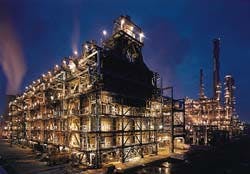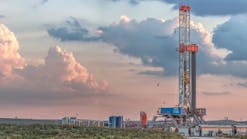David Knott
Senior Editor
Work is shown under way at Grangemouth petrochemical plant in January to expand capacity of the KG ethylene cracker, one of two at the site. Here, a furnace is being upgraded to help raise the cracker's capacity to 450,000 tons/year from 350,000 tons/year. Photo courtesy of BP.British Petroleum Co. plc has ambitious expansion plans for its Grangemouth refinery and petrochemical complex near Edinburgh, to maximize use of its unusual combination of nearby sites.
The complex is unique within the company in having BP's three main businesses directly linked: BP Exploration operates Kinneil crude oil processing terminal; BP Oil operates Grangemouth refinery; and BP Chemicals operates Grangemouth petrochemical plant.
Kinneil terminal processes oil that arrives from 21 North Sea fields via the BP-operated Forties pipeline system. It has capacity to stabilize more than 1 million b/d of crude oil.
The terminal removes gas and natural gas liquids from the crude oil. Crude oil is sent to the refinery and to nearby Hound Point export terminal; gas and NGL are piped to the petrochemical plant for feedstock.
About 20% of Kinneil's crude is directed to the refinery; the remainder is exported, mainly by tanker to Europe. The plant also yields 2,500 metric tons/day of dry gas, 2,000 tons/day of propane, and 2,000 tons/day of butane.
The refinery has crude distillation capacity of 205,000 b/d. BP Oil is currently working to improve the portion of middle distillates in its products, as part of a bid to keep improving refining margins.
The petrochemical plant currently has capacity to produce 600,000 tons/ year of ethylene and 450,000 tons/year of polyethylene.
BP Chemicals intends to make Grangemouth a world-scale petrochemical complex, with capacity to produce 1.2 million tons/year of ethylene after a series of upgrades to the twin cracker plant.
By then, polymer production capacity is expected to amount to 1 million tons/year through addition of polyethylene capacity and construction of a new polypropylene plant.
Mike Buzzacott, BP Chemicals' chief executive for polymers and olefins worldwide, said that the U.K. is a net importer of most of the chemicals produced at Grangemouth.
"Hence," said Buzzacott, "BP is confident it can expand production there. We have a unique low-cost feedstock position here and growing market demand."
Synergy
Alan Bilsland, works general manager at BP Chemicals, Grangemouth, apologizes for using the word "synergy," but explains that integration of the three businesses in one complex provides just that."There is a simple chain from oil terminal to petrochemicals site," Bilsland told OGJ, "which results in the petrochemical plant getting advantaged feedstock, which in turn provides development opportunities."
Availability of C2, C3, and C4 gas liquids from Kinneil terminal and availability of naphtha from the refinery have given the petrochemical unit an advantageous flexibility of feedstocks.
The plant has two ethylene crackers: the G4 unit, which can be run on naphtha and gas, and the KG unit, which runs on gas liquids.
"Europe traditionally doesn't use gas crackers," said Bilsland. "Grangemouth is unique in Europe in having access to both feedstocks at one site.
"The chemical industry tends to go through big cycles, but in BP we have been saying it is vital to have disciplined growth. Our aim is to match the market, but grow only where we have an advantage.
"At Grangemouth there is advantage through location, feedstock availability and flexibility, and technologically exciting projects that can bring on new capacity at a much lower cost than newbuilding."
Kinneil expansion
The Kinneil terminal was built with the North Sea's Forties export pipeline in the 1970s.As Forties field production has declined, third-party producers have increasingly taken capacity in the pipeline.
Such has been the demand for central North Sea export facilities that BP has expanded system capacity to more than 1 million b/d of oil in the early 1990s.
This has involved a related investment of £850-900 million at Kinneil terminal during the last 5 years, said Bilsland.
Forties pipeline throughput is expected to increase still further when Elf Exploration U.K. plc and Shell U.K. Exploration & Production bring on stream Elgin/Franklin and Shearwater developments, respectively.
The refinery takes as much as 205,000 b/d of crude oil, and the remainder is piped to Dalmeny tank farm, near Hound Point. Here are eight storage tanks with total capacity of 4 million bbl.
Stabilized crude oil is piped from there to one of two tanker-loading jetties on the river at Hound Point. Typically, one ship each day takes away a cargo of 300,000 metric tons of crude oil.
David Patterson, process engineer at BP Chemicals, said that 21 offshore fields feed into the Forties pipeline system, and there is a waiting list of future developments. Hence, BP is planning to expand Kinneil plant throughput capacity to 1.2 million b/d.
Refinery repositioning
As part of its global strategy to operate only refineries with returns among the top 25% in the industry, BP Oil is carrying out a £250 million repositioning program to put Grangemouth in this category.Grangemouth is the only refinery in Scotland. It supplies Scotland, northern England, and Northern Ireland with petroleum products.
A pipeline link to a tanker loading terminal on Scotland's western coast is the route for exports to Northern Ireland. This terminal and pipeline are also occasionally used to import crude oil when the refinery wishes to run a blend other than Forties.
The refinery has three distillation units: a 60,000 b/d unit built in the 1950s, a 40,000 b/d unit built in the 1960s, and a 100,000 b/d unit added in the 1970s.
The plant includes a 70,000 b/d capacity vacuum distillation unit, a 21,000 b/d catalytic cracker, and a 32,000 b/d hydrocracking unit, which has just been modified to increase low-sulfur middle distillates output.
Grangemouth refinery also in- cludes two hydrodesulfurizers and a 35,000 b/d hydrofiner for low-sulfur diesel production, a catalytic reformer, an alkylation unit, and a cryogenic plant.
Central to the repositioning program is the catalytic cracker, which BP recently revamped under a £25 million ($40 million) program. A similar amount is being spent on a current project to modify the unit to accept heavier crude oils.
Sixty percent of the refinery products is exported by sea, 25% by road, and the remainder is split roughly equally between pipeline and rail exports.
John Williams, general manager of BP Oil at Grangemouth site, said that while the refinery is in the top quartile of performers in Europe, it is not independent of margins.
However, the set-up of the plant and its links with the other plants at the complex help make the refinery "...better insulated from the cycles" in the refining industry than most others: "We make very good profits in the good times."
Williams explained that BP is pursuing a simple two-track strategy for the refinery: "First get the kit right, then get the operation right. We're now well down the track on getting the kit right."
The first stage of upgrading was completed by yearend 1996 and involved upgrading the cracker to handle heavier crude oils and to increase middle distillates production capacity to 40,000 b/d from 35,000 b/d.
"We're working on the second stage of upgrading now," said Williams. "We'll have a new front end in place next year, and we intend to install a solvent de-asphalter. We are at the engineering stage for this work."
For the future, refinery capacity is unlikely to be expanded under current plans, explained Williams, although crude throughput could be expanded a little at a later stage under the current refinery configuration.
Instead, BP will make better use of conversion plant, optimizing blending components to increase middle distillate yields still further and to optimize gasoline production.
"We are extremely well placed for producing low-sulfur diesel," said Williams. "If the industry gets even tighter quality specifications for diesel, we are well-positioned to meet them."
Petrochemical plans
In the near term, BP Chemicals has sanctioned £500 million for cracker upgrades, but further investment is also envisioned to take ethylene plant capacity beyond the 1 million ton/ year mark and to expand ethylene output and install a polypropylene unit.
At the moment, BP is carrying out engineering work for an upgrade of the KG ethylene cracker, which will take its capacity to 450,000 tons/ year from 350,000 tons/year.
Bilsland said this incremental capacity will be added at less than 25% of the cost of building a new 100,000 ton/ year plant.
BP has just announced its intention to increase capacity of the G4 ethylene cracker to 350,000 tons/year from 250,000 tons/year by yearend 1998.
Wilson Bissell, special projects manager at Grangemouth, said the G4 cracker has 12 furnaces, arranged in two banks of six.
Under a £35 million ($56 million) project, one bank of six furnaces will be replaced in mid-1998. This will raise throughput capacity by 100,000 tons/ year.
At a later date, BP could replace the second bank of furnaces. Bissell said this would increase ethylene capacity by a further 200,000-300,000 tons/year.
"Replacing the second bank would be dependent on increased feedstock availability and ethylene demand," said Bissell. "This is the next investment decision we'll have to take."
Patterson said replacing six "ancient" furnaces with state-of-the-art furnaces-two twin cell units manufactured by Stone & Webster Engineering Ltd., Milton Keynes, U.K.-will improve selectivity towards ethylene.
The company is also studying feasibility of a further project to expand capacity of the KG cracker further, which would take the unit's capacity to 700,000 tons/year. This extra 250,000 tons/year would cost less than 50% of newly built capacity.
Patterson said this would include installation of three new twin cell furnaces and could also involve improvements in flexibility to use naphtha feedstock, along with installation of a parallel compression train and modifications to the back end.
"This would take the site to more than 1 million tons/year capacity of ethylene," said Bilsland, "making Grangemouth a world scale plant.
"To enable us to plan for raising capacity to 1.05 million tons/year, we have in parallel had to find an extra 300,000 tons/year derivatives use, so we will also increase our polyethylene and ethanol capacity.
"We could theoretically increase G4 capacity still further to 500,000 tons/ year, which would give us 1.2 million tons/year of ethylene capacity, but we would do this only if there is sufficient demand for derivative products."
BP intends to match each increment of new ethylene capacity at Grangemouth with a user, so that the company avoids dumping ethylene on the market.
Bissell said Grangemouth currently has capability to produce 280,000 tons/year of high density polyethylene and 180,000 tons/year of linear low density polyethylene.
Besides its own derivatives manufacturing plans, BP is talking with other polyethylene companies regarding joint ventures and manufacturing, in which some Grangemouth capacity could be used by other producers.
Polypropylene
BP is proposing to build a 250,000 ton/year polypropylene plant on a site within the Grangemouth complex, under a joint venture with Elf Ato- chem SA.
The venture, known as Appryl and owned 51% by Elf and 49% by BP, hopes to have the polypropylene unit commissioned by yearend 1999. It will take as feedstock propylene produced in the crackers and the refinery and currently exported from nearby docks.
Bissell said the crackers and refinery currently produce a total 300,000 tons/year of propylene, all of which is exported to European polypropylene manufacturers.
The crackers produce chemical-grade propylene, while the refinery's propylene is upgraded for polymerization.
The planned polypropylene unit will be upgradeable to 300,000 metric tons/year, said Bissell. This is expected to take place in 2002. This will then be the largest single-train polypropylene plant.
"Both new polyethylene and polypropylene capacity will be commissioned in fourth quarter 1999," said Bissell, bringing more than half a million tons/year of polymer capacity on stream at one time.
"The capacity of Grangemouth to make bulk polymers will virtually double overnight. For exports of this material, we will have to put in place new logistics to cope with the volume. We are looking into a rail connection, but the problem with rail is its high set-up cost."
Buzzacott said U.K.'s polypropylene demand currently amounts to 1 million tons/year. Construction of a new polypropylene plant at Grangemouth will mean demand will be almost met.
But polypropylene demand is expected to rise in the U.K. at 5%/year, while Europe as a whole is expected to continue tight or slightly in deficit regarding polypropylene capacity.
Buzzacott said board approval for the polypropylene plant is anticipated in the fourth quarter 1997, after which an engineering, procurement, and construction contract will be let.
"Don't expect a conventional approach to this contract," said Buzzacott. "We have already identified contractors we intend to work with, and we intend to award gainshare contracts under an alliancing scheme."
Grangemouth ethylene cracker is linked to U.K.'s two other crackers through the Ethylene Pipeline System. This grid connects Grangemouth with Mossmorran, Teesside, and Runcorn.
At Mossmorran, Exxon Chemicals Ltd. and Shell Chemicals Ltd. operate an 800,000 ton/year ethylene plant. At Teesside, ICI Chemicals Ltd. produces 850,000 tons/year of ethylene, and at Runcorn, ICI has a large petrochemical complex that uses ethylene feedstock from the grid.
The operators are debating whether to link the U.K. ethylene grid to Europe by means of a new ethylene pipeline.
Bilsland said the three U.K. crackers are among the top six of Europe's 55 ethylene crackers, and a pipeline link to Europe would bring added strength to Grangemouth.
BP also has a polyketones pilot plant in operation at Grangemouth. Polyketones are engineering materials that are being introduced particularly where good barriers are required-for example in bottles-and for high-temperature applications.
Bissell said BP has proved its polyketones process with the pilot plant and is now considering building a commercial plant within the Grangemouth complex.
"As this would be the first plant of its kind within BP," said Bissell, " it would be likely to be of modest scale. But if we are going to have a polyketones plant, and if we are going to build it at Grangemouth, then installing it beside the polyethylene and polypropylene units and using the same distribution system has a nice ring to it."
Feedstocks for polyketones are carbon monoxide, ethylene, and propylene, said Bissell. While the BP process is still at the developmental level, he said "...we will have a clearer view of what to do with polyketones next year."
Local petrochemical plants already take various outputs from Grangemouth to use as feedstock: Enichem SpA, Rohm & Haas (U.K.) Ltd., and GE Plastics have plants nearby.
From Kinneil, these plants receive liquefied petroleum gas by pipeline. They also take ethanol, polybutenes and benzene, production of which will also rise as a result of the planned expansion program. BP is looking into further investments to maximize returns from these products.
Shared facilities
BP has only recently begun to operate Grangemouth as a combined site, having previously operated the crude oil terminal, refinery, and chemical sites through their respective operating divisions.
Now the exploration, oil, and chemical divisions are working to coordinate major plant shutdowns, as well as staffing requirements, training, and site maintenance.
A 140-MW cogeneration plant on the site provides most of the electricity and steam required by the refinery and chemical site. When steam production is maximized, the site needs to draw electricity from the grid.
The power station is normally fed with gas from Kinneil terminal, but it can burn residual oil from the refinery if required.
BP has approved construction of a 90-MW cogen plant at Grangemouth. Also, a number of power generators have expressed interest in building a plant there to supply Grangemouth complex and export electricity to the national grid.
Copyright 1997 Oil & Gas Journal. All Rights Reserved.



